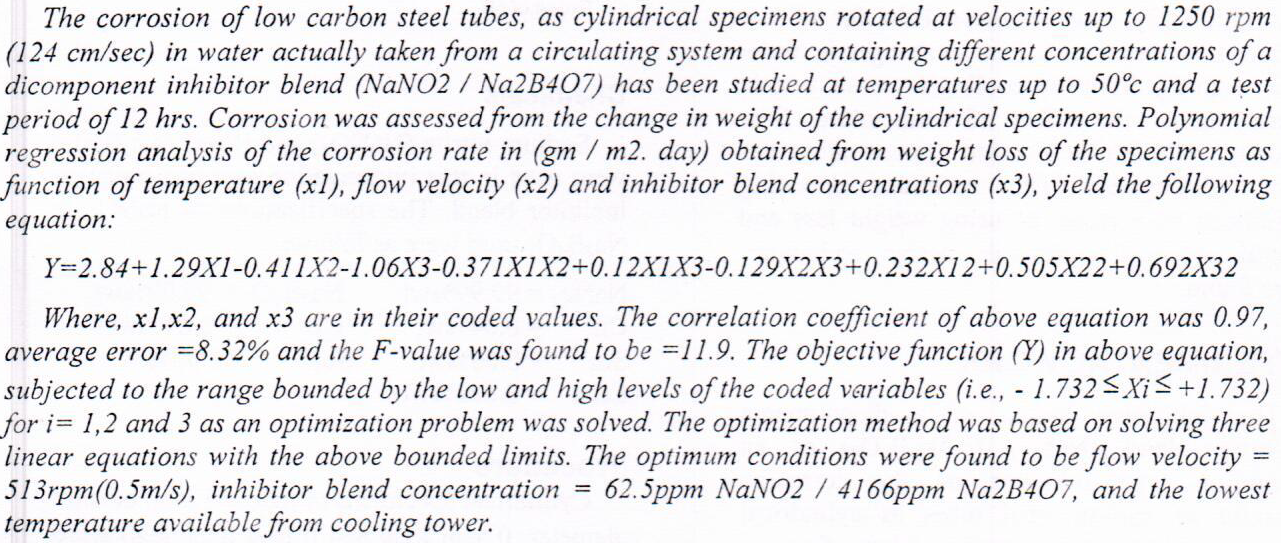
The impact of a Schiff base namely 2-((thiophen-2-ylmethylene)amino)benzenethiol to corrode mild steel in 1 M HCl resolved was evaluated using different weight loss technique and scanning electron microscopy (SEM).different weight measurements to expand that the 2-((thiophen-2-ylmethylene) amino) benzenethiol inhibits the corrosion of mild steel through adsorbing of top for mild steel and block the active locality. The inhibitive impacts of 2-((thiophen-2-ylmethylene)amino)benzenethiol increase with increasing concentration and decrease with increasing temperature. SEM to checking revealed that the alloy surface was quite unaffected and formed protective film on its surface. The investigated
... Show More (4)
(4)
 (1)
(1)
Galvanic corrosion of stainless steel 316 (SS316) and carbon steel (CS) coupled in 5% wt/v sulfuric acid solution at agitation velocity was investigated. The galvanic behavior of coupled metals was also studied using zero resistance ammeter (ZRA) method. The effects of agitation velocity, temperature, and time on galvanic corrosion current and loss in weight of both metals in both free corrosion and galvanic corrosion were investigated. The trends of open circuit potential (OCP) of each metal and galvanic potential (Eg) of the couple were, also, determined. Results showed that SS316 was cathodic relative to CS in galvanic couple and its OCP was much more positive than that of CS for all investigated ranges of
... Show MoreThe corrosion of low carbon steel boiler tubes in demi water had been investigated. The purpose of this investigation was to determine the change produced in corrosion behavior of the carbon steel as a result of the specific presence of chloride and copper ions in the water under different temperatures. For low carbon steel experiments, the temperature was taken in three levels (125, 175, and 215°C) under about 27 bar pressure and 1500 rpm in autoclave. Using weight loss technique, the corrosion rate ranges from (85 to 789 gmd) for low carbon steel boiler tubes.
The research involved attempt to inhibit the corrosion of Al-Si-Cu alloy in 2.5x10-3 mol.dm-3 NaOH solution (pH=11.4) by addition of six different inhibitors with three concentrations (1x10-3, 1x10-2, and 0.1 mol.dm-3). These inhibitors include three organic materials (sodium acetate, sodium benzoate, and sodium oxalate) and three inorganic materials (sodium chromate, disodium phosphate, and sodium sulphate). The data that concerning polarization behaviour are calculates which include the corrosion potential (Ecorr) and current density (icorr), cathodic and anodic Tafel slopes (bc & ba), and polarization resistance (Rp). Protection efficiency (P%) and activation energy (Ea) values were calculated for inhibition by the six inhibitors. The
... Show MoreThe main factors that make it possible to get the corrosion of reinforcing steel in concrete are chloride ions and the absorption of carbon dioxide from the environment, and each of them works with a mechanism which destroys the stable immunity of rebar in the concrete. In this work the effect of carbon dioxide content in the artificial concrete solution on the corrosion behavior of carbon steel reinforcing bar (CSRB) was studied, potentiostatically using CO2 stream gas at 6 level of concentrations; 0.03 to 2.0 weight percent, and the effect of rising electrolyte temperature was also followed in the range 20 to 50ᴼ C. Tafel plots and cyclic polarization procedures were obeyed to investigate the c
... Show More (13)
(13)
 (2)
(2)
 (1)
(1)
The ability to inhibit corrosion of low carbon steel in a salt solution (3.5%NaCl) has been checked with three real expired drugs (Cloxacillin, Amoxicillin, Ceflaxin) with variable concentrations (0, 250, 500, 750) mg/L were examined in the weight loss. The inhibition efficiency of the Cloxacillin 750 mg/L showed the highest value (82.8125 %) and the best inhibitor of the rest of the antibiotics. The different concentrations of Cloxacillin drug (0, 250, 500, 750) mg/L and temperature (25, 35, 45, 55) oC were studied as variables with potentiodynamic polarization, Scanning Electron Microscopy (SEM) for surface morphology and electrochemical impedance spectroscopy (EIS) depending on current values and the resistance of charge to
... Show More (1)
(1)
 (1)
(1)
The corrosion inhibition of aluminum alloy 5083 by an environment friendly compound called (8- Hydroxyquinoline) in
acidic and alkaline solutions of pH (2 and 12) respectively were studied using weight loss and polarization techniques.
Also to examine the main and combined effects of the inhibitor concentration, pH, and contact time using factorial
experimental design. Results show that corrosion rate decreased with increasing both inhibitor concentration and
contact time and increased with increasing pH value. The polarization curves show that 8-hydroxyquinoline is a
cathodic inhibitor
Nitinol (NiTi) is used in many medical applications, including hard tissue replacements, because of its suitable characteristics, including a close elastic modulus to that of bones. Due to the great importance of the mechanical properties of this material in tissue replacements, this work aims to study the hysteresis response in an attempt to explore the ability of the material to remember its previous mechanical state in addition to its ability to withstand stress and to obtain the optimal dimensions and specifications for the manufacturer of NiTi actuators. Stress-strain examination is done in a computational way using a mutable Lagoudas MATLAB code for various coil radii, environment temperatures, and coil lengths. The computational m
... Show More (1)
(1)
Nanoparticles (NPs) based techniques have shown great promises in all fields of science and industry. Nanofluid-flooding, as a replacement for water-flooding, has been suggested as an applicable application for enhanced oil recovery (EOR). The subsequent presence of these NPs and its potential aggregations in the porous media; however, can dramatically intensify the complexity of subsequent CO2 storage projects in the depleted hydrocarbon reservoir. Typically, CO2 from major emitters is injected into the low-productivity oil reservoir for storage and incremental oil recovery, as the last EOR stage. In this work, An extensive serious of experiments have been conducted using a high-pressure temperature vessel to apply a wide range of CO2-pres
... Show More